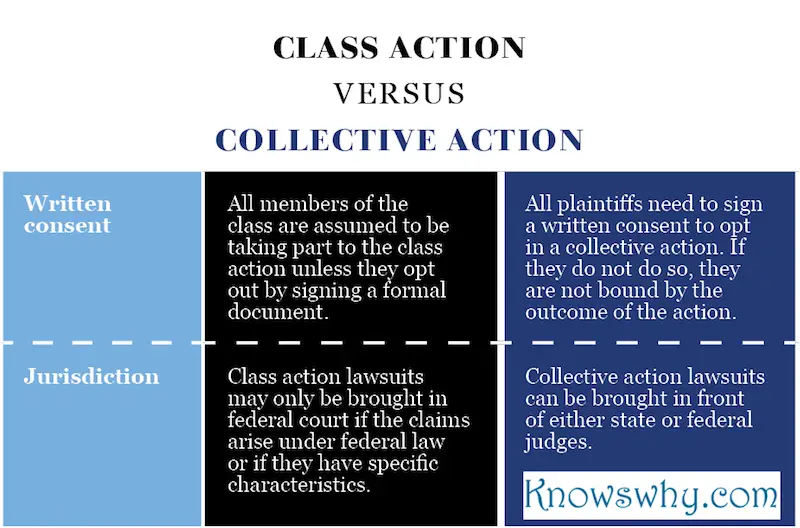The American legislation contains provisions according to which individuals can file a class action or a collective action in order to see their rights upheld and protected. Pursuing a class or a collective legal action allows the plaintiff (the person who files the suit) to share the costs and to – possibly – have access to courts and obtain a just and fair resolution. Furthermore, collective claims are often more powerful and the chances of winning are higher – in particular against large corporations. Class action and collective action have many similarities, but at the same time, we can identify some key differences.

What is Class Action?
In a class action, one person (the plaintiff) or few individuals can file a lawsuit on behalf of a group of other persons who have similar circumstances (the class). While the plaintiff can start the lawsuit on behalf of the class, the judge has to “grant certification” – in other words, the judge has to allow the plaintiff to continue the legal action on behalf of the entire class. If the judge does not grant certification, the plaintiff can only continue with his/her individual case. Choosing a class action over an individual suit has various benefits:
- Legal costs may be reduced if spread across the entire class;
- The case of the plaintiff is stronger if it is supported by more people; and
- At the end of the trial, the judge can decide to compensate the named plaintiff for his/her efforts on behalf of the entire class.
The number of people who can take part to a class action is not limited and one single named plaintiff is enough to represent a much larger class.

What is Collective Action?
A collective action must be analyzed within the context of the FLSA (Fair Labor Standard Law) and can be filed by all (or part of) employees of a given company. For instance, a collective action lawsuit can be filed if the employees have been denied some of the basic rights provided for by the FLSA, such as minimum wage and overtime pay. In order to start a collective action, the employees must be “similarly situated” – which means that they must be subject to a common contract or policy, regardless of their role or the department or the location they work in.
Similarities between Class Action and Collective Action
Class action and collective action share some basic features, but they are two different legal solutions and entail different procedures. Some of the main similarities between the two are listed below:
- In both cases, the lawsuit is filed on behalf of a group of people who are in similar situations or circumstances;
- Filing a class action or a collective action gives more strength to all individual cases; and
- In both cases, individuals are protected by the group and legal costs can be shared by all participants.
What is the Difference between Class Action and Collective Action?
Some of the main differences between class action and collective action concern rules and procedures:
- Class actions cannot be used to assert claims linked to FLSA regulations (i.e. overtime pay, wage, etc.) while collective action lawsuit are designed to protect and promote employees’ rights; and
- In order to be a part of a collective action, an individual must opt in (which means he/she has to sign a formal document saying he/she wishes to be a part of the lawsuit) whereas in class actions individuals must opt out if they do not want to be a part of the lawsuit.
Class Action vs Collective Action
Building on the differences outlined in the previous section, we can identify other elements that differentiate the two concepts.

Summary
Class action and collective action lawsuits can be used to put forward claims made by a group of people. In both cases, all plaintiffs must be in similar circumstances and situations, and must be willing to act as a group to obtain justice and reparation. In order to be a part of a class action, individuals do not have to sign any written consent but they can opt out if they do not wish to be a part of the class; conversely, plaintiffs must sign a written agreement if they want to be part of a collective action lawsuit.












Leave a Reply